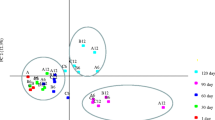Abstract
The use of a freeze-dried Tibetan kefir co-culture as a starter for production of Camembert-type cheese was investigated. Maturation of produced cheese was monitored for 35 days and the chemical composition, proteolysis, lipolysis, and volatile compounds were studied. The cheese underwent proteolysis. The content of pH 4.6-soluble nitrogen, 12% trichloroacetic acid-soluble nitrogen, and the total free amino acid content increased while the total nitrogen content decreased. Palmitic, myristic, oleic, and capric acid were the representative free fatty acids, which increased in amount during ripening. A total of 45 compounds were detected, including 16 acids, 8 ketones, 6 alcohols, 7 esters, and 8 unclassified compounds. Volatile carboxylic acids were abundant in the headspace of the cheese.
Similar content being viewed by others
References
Simova E, Beshkova D, Angelov A, Hristozova T, Frengova G, Spasov Z. Lactic acid bacteria and yeasts in kefir grains and kefir made from them. J. Ind. Microbiol. Biot. 28: 1–6 (2002)
Goncu A, Alpkent Z. Sensory and chemical properties of white pickled cheese produced using kefir, yoghurt or a commercial cheese culture as a starter. Int. Dairy J. 15: 771–776 (2005)
Katechaki E, Panas P, Rapti K, Kandilogiannakis L, Koutinas AA. Production of hard-type cheese using free or immobilized freezedried kefir cells as a starter culture. J. Agr. Food Chem. 56: 5316–5323 (2008)
Kourkoutas Y, Kandylis P, Panas P, Dooley JSG, Nigam P, Koutinas AA. Evaluation of freeze-dried kefir coculture as starter in Feta-type cheese production. Appl. Environ. Microb. 72: 6124–6135 (2006)
Chen L, Cui J, Ding Q, Ma Y, Chen L, Dong J, Jiang T, Maubois J, The effect of yeast species from raw milk in China on proteolysis and aroma compound formation in Camembert-type cheese. Food Bioprocess Tech. 5: 2548–2556 (2012)
Deeth HC, Touch V. Methods for detecting lipase activity in milk and milk products. Aust. J. Dairy Technol. 55: 153–168 (2000)
Bua M, Guamis B, Pavia M, Trujillo AJ. Lipolysis in cheese made from raw, pasteurized or high-pressure-treated goats’ milk. Int. Dairy J. 11: 175–179 (2001)
Hayaloglu AA. Volatile composition and proteolysis in traditionally produced mature Kashar cheese. Int. J. Food Sci. Tech. 44: 1388–1394 (2009)
Leclercq-Perlat MN, Buono F, Lambert D, Latrille E, Spinnler HE, Corrieu G. Controlled production of Camembert-type cheeses. Part I: Microbiological and physicochemical evolutions. J. Dairy Res. 71: 346–354 (2004)
Le Graet Y, Brulé G. Migration of macro and oligo-elements in a soft cheese like Camembert. Lait 68: 219–234 (1988)
Arslan S, Topcu A, Saldamli I, Koksal G. Utilization of interesterified fat in the production of Turkish white cheese. Food Sci. Biotechnol. 19: 89–98 (2010)
Leclercq-Perlat MN, Oumer A, Buono F, Bergere JL, Spinnler HE, Corrieu G. Behavior of Brevibacterium linens and Debaryomyces hansenii as ripening flora in controlled production of soft smear cheese from reconstituted milk: Protein degradation. J. Dairy Sci. 83: 1674–1683 (2000)
Deeth HC, Fitz-Gerald CH. Lipolysis in dairy products: A review. Aust. J. Dairy Technol. 31: 53–64 (1976)
Alewijn M, Sliwinski EL, Wouters JTM. A fast and simple method for quantitative determination of fat-derived medium and lowvolatile compounds in cheese. Int. Dairy J. 13: 733–741 (2003)
Jeon SS, Lee SJ, Ganesan P, Kwak HS. Comparative study of flavor, texture, and sensory in cream cheese and cholesterolremoved cream cheese. Food Sci. Biotechnol. 21: 159–165 (2012)
Guizani N, Kasapis S, Al-Attabi ZH, Al-Ruzeiki MH. Microbiological, physicochemical, and biochemical changes during ripening of Camembert cheese made of pasteurized cow’s milk. Int. J. Food Prop. 5: 483–494 (2002)
Deiana P, Fatichenti F, Farris GA, Mocquot G, Lodi R, Todesco R, Cecchi L. Metabolization of lactic and acetic acids in Pecorino Romano cheese made with a combined starter of lactic acid bacteria and yeast. Lait 64: 380–394 (1984)
Izco JM, Torre P. Characterisation of volatile flavor compounds in Roncal cheese extracted by the ‘purge and trap’ method and analysed by GC-MS. Food Chem. 70: 409–417 (2000)
Kondyli E, Katsiaria MC, Masourasb T, Voutsinasa LP. Free fatty acids and volatile compounds of low-fat Feta-type cheese made with a commercial adjunct culture. Food Chem. 79: 199–205 (2002)
Leclercq-Perlat MN, Corrieu G, Spinnler HE. Controlled production of Camembert-type cheeses: Part III role of the ripening microflora on free fatty acid concentrations. J. Dairy Res. 74: 218–225 (2007)
Collins YF, McSweeneyb PLH, Wilkinsonc MG. Lipolysis and free fatty acid catabolism in cheese: A review of current knowledge. Int. Dairy J. 13: 841–866 (2003)
Wolf IV, Perotti MC, Bernal SM, Zalazar CA. Study of the chemical composition, proteolysis, lipolysis, and volatile compounds profile of commercial Reggianito Argentino cheese: Characterization of Reggianito Argentino cheese. Food Res. Int. 43: 1204–1211 (2010)
Urgeghe PP, Piga C, Addis M, Di Salvo R, Piredda G, Scintu MF, Wolf IV, Sanna G. SPME/GC-MS characterization of the volatile fraction of an Italian PDO sheep cheese to prevalent lypolitic ripening: The case of Fiore Sardo. Food Anal. Method. 5: 723–730 (2012)
Kubícková J, Grosch W. Evaluation of potent odorants of Camembert cheese by dilution and concentration techniques. Int. Dairy J. 7: 65–70 (1997)
Yvon M, Rijnen L. Cheese flavor formation by amino acid catabolism. Int. Dairy J. 11: 185–201 (2001)
Delgado FJ, González-Crespo J, Cava R, Ramírez R. Changes in the volatile profile of a raw goat milk cheese treated by hydrostatic high pressure at different stages of maturation. Int. Dairy J. 21: 135–141 (2011)
Moio L, Addeo F. Grana Padano cheese aroma. J. Dairy Res. 65: 317–333 (1998)
Ha JK, Lindsay R. Volatile branched-chain fatty acids and phenolic compounds in aged Italian cheese flavors. J. Food Sci. 56: 1241–1247 (1991)
Author information
Authors and Affiliations
Corresponding author
Rights and permissions
About this article
Cite this article
Mei, J., Guo, Q., Wu, Y. et al. Study of proteolysis, lipolysis, and volatile compounds of a Camembert-type cheese manufactured using a freeze-dried Tibetan kefir co-culture during ripening. Food Sci Biotechnol 24, 393–402 (2015). https://doi.org/10.1007/s10068-015-0052-9
Received:
Revised:
Accepted:
Published:
Issue Date:
DOI: https://doi.org/10.1007/s10068-015-0052-9




